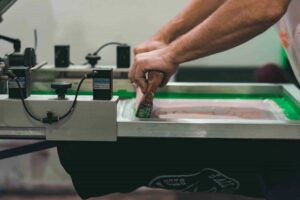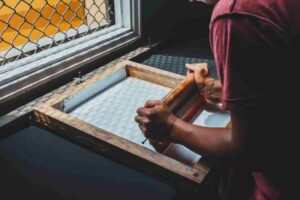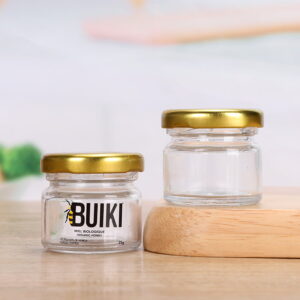Silk printing, also known as screen printing, is a versatile and popular method of applying designs and text onto various surfaces, including glass. Discovered over a thousand years ago in China, this technique has evolved significantly, finding its place in modern manufacturing and design. Silk printing originated in China during the Song Dynasty (960–1279 AD). It was initially used for decorating fabrics, especially silk, hence the name ‘silk printing. The technique spread to other Asian countries, like Japan, and eventually reached Western countries in the 18th century.
Section 1 Modern Silk Printing Process
The modern process of silk printing, also known as screen printing, has evolved significantly from its traditional roots. While the basic principle remains the same – pushing ink through a screen onto a substrate – advancements in technology and materials have refined and expanded its applications. Here’s a detailed look at the contemporary silk printing process:
▶ Preparing the Design
○ Digital Artwork: The process begins with a digital design, often created using software like Adobe Illustrator or Photoshop. This design determines what will be printed on the substrate.
○ Film Output: The digital design is printed onto a transparent film to create a ‘positive’. This film will be used to develop the stencil on the screen.
▶ Screen Preparation
○ Selecting the Screen: Screens with different mesh counts are chosen based on the detail and type of the design. A higher mesh count is used for finer details.
○ Coating with Emulsion: The screen is coated with a light-sensitive emulsion. This emulsion hardens when exposed to light, creating the basis for the stencil.
▶ Exposing the Screen
○ Placing the Film: The film positive is placed on the emulsion-coated screen.
○ Exposure Unit: The screen is exposed to a strong light source in an exposure unit. The areas of the emulsion covered by the design on the film do not harden and can be washed out.
○ Developing the Stencil: After exposure, the screen is washed with water. The unhardened emulsion washes away, leaving a negative stencil of the design on the screen.

▶ Setting Up for Printing
○ Aligning the Screen: The screen is aligned over the substrate (e.g., a glass bottle, textile, or paper) to ensure accurate placement of the design.
○ Mixing the Ink: Inks are mixed to match the desired color. Specialized inks are used for different substrates, such as glass or textiles.
▶ Printing
○ Application of Ink: Ink is placed on top of the screen, and a squeegee is used to evenly press the ink through the open areas of the stencil.
○ Multiple Colors: For designs with multiple colors, the process is repeated with different screens for each color, requiring precise alignment for each layer.
▶ Curing and Finishing
○ Drying the Ink: The printed substrate is dried or cured. For materials like textiles, a conveyor dryer is used, while for glass, a UV light or heat process may be employed.
○ Quality Check: The final product is inspected for any defects or misalignments.
The modern silk printing process, with its blend of traditional techniques and cutting-edge technology. It offers unparalleled versatility and quality. It is particularly effective for projects requiring high levels of detail, custom designs, or large production runs. For industries like glass bottle manufacturing, silk printing provides a durable, high-quality, and cost-effective solution for branding and decorating products.
Section 2 Features and Advantages of Silk Printing
One of the standout features of silk printing is its versatility. It can be applied to a wide range of materials, including textiles, glass, metal, and plastic, using different types of inks to suit specific needs. This adaptability is complemented by the durability of the prints, which are resistant to fading, peeling, and environmental wear. Which makes them suitable for both indoor and outdoor applications.
The vibrancy and opacity of the colors achieved through silk printing are unmatched. The technique allows for the application of a thicker layer of ink, resulting in colors that are rich and stand out, even on darker materials. This aspect is particularly important in industries where brand recognition and visual appeal are crucial.
Additionally, silk printing is cost-effective, especially for large-scale production. While the initial setup might be resource-intensive, the process becomes more economical for bulk orders due to its efficiency in mass production. This makes it a preferred choice for businesses looking to produce high volumes of printed materials.
In recent years, there has been a shift towards more eco-friendly practices in silk printing, with the development of sustainable inks and processes that generate less waste. This evolution reflects a growing industry trend towards environmental responsibility.

Section 3 Applications of Silk Printing
Silk printing has a wide range of applications across various industries, with its use in glass bottles and jars being particularly noteworthy. Here’s an overview of its applications with a special focus on glass packaging:
▶ Glass Bottles and Jars
Branding and Labeling: Silk printing is extensively used for branding and labeling on glass bottles and jars. This is particularly prevalent in the food and beverage industry. Where the appearance of packaging plays a crucial role in brand recognition and customer appeal.
Durability: The prints are highly durable and capable of withstanding handling, washing, and exposure to various conditions without fading or peeling. This longevity is essential for products like wine bottles, beer bottles, and spirit bottles. Which often go through extensive handling and storage.
Aesthetics: Silk printing allows for the application of vibrant, opaque inks that can create elegant and visually appealing designs. This is key for premium brands in the wine and spirits industry, where the packaging design significantly contributes to the product’s perceived value.
▶ Textile Industry
Clothing and Apparel: It’s widely used for printing designs on t-shirts, dresses, and various other garments. The ability to produce vibrant colors and detailed designs makes it ideal for fashion and apparel.
▶ Marketing and Promotional Items
Merchandise: Silk printing is used for creating customized promotional products like posters, banners, bags, and other merchandise. Its versatility allows for printing on various materials, making it a go-to method for promotional branding.
▶ Electronics and Industrial Applications
Circuit Boards and Components: In the electronics industry, silk printing is used for applying conductive traces and insulating layers on circuit boards.
Product Labeling: Durable labels for machinery and industrial products are often created using silk printing due to their resistance to wear and environmental factors.
▶ Graphic Design and Art
Art Prints and Posters: Artists and graphic designers frequently use silk printing for creating art prints, posters, and other creative works, appreciating the unique textures and finishes it can produce.
▶ Home Decor and Ceramics
Decorative Elements: Silk printing is also employed in the production of decorative elements on ceramics, glassware, and home decor items, where precision and durability are essential.
In the context of wholesale empty glass bottles and jars in bulk, silk printing stands out for its ability to deliver high-quality, durable, and aesthetically pleasing designs. This makes it a preferred choice for businesses that prioritize branding and presentation. Such as those in the wine, spirits, and gourmet food industries. The process ensures that the packaging not only protects the product but also enhances its visual appeal, playing a critical role in marketing and brand differentiation.

Section 4 The Future of Silk Printing in Glass Packaging
The future of silk printing in glass packaging is poised for significant evolution, driven by a blend of technological innovation and a growing emphasis on sustainability. As the integration of digital technologies progresses, we can expect to see more precise and automated processes in silk printing. This advancement will not only enhance production efficiency but also improve the consistency and quality of prints, a critical aspect for branding and aesthetic appeal in glass packaging.
A major trend that will shape the future of silk printing is the industry’s shift towards sustainability. The development of eco-friendly inks and processes that minimize environmental impact is becoming increasingly important. These advancements include biodegradable and non-toxic inks, as well as techniques that reduce waste and energy consumption. Additionally, as recycling becomes more prevalent, silk printing methods that are compatible with glass recycling processes will gain prominence. Ensuring that the decorative aspects of packaging do not impede environmental sustainability.
Customization and personalization will also play a significant role in the future of silk printing. With market trends leaning towards personalized and small-batch products, especially in premium and craft beverage sectors, silk printing’s flexibility and scalability make it an ideal choice. Moreover, the incorporation of interactive elements like QR codes and augmented reality in prints could open new avenues for consumer engagement. Adding a new dimension to product packaging.
Lastly, with increasing consumer awareness of health and safety, silk printing processes and materials that are safe and non-toxic, particularly for food and beverage containers, will be in higher demand. This shift will be accompanied by stricter regulatory compliance regarding packaging materials and processes. Focusing on both consumer safety and environmental impact.
Discover Silk Printing Innovations at Smilebottles
Smilebottles’ exploration of advanced silk printing techniques offers a treasure trove of customization possibilities for wholesale glass containers. Whether it’s through seasonal and cultural themes, interactive elements like QR codes and AR, or personalized touches for special occasions, these innovative silk printing ideas can significantly elevate your brand’s presence. Embracing eco-friendly messages, collaborating with artists, and experimenting with unique colors and textures are just the beginning of what can be achieved. At Smilebottles, we are committed to pushing the boundaries of glass container design, ensuring that every product not only meets but exceeds the expectations of our clients and their consumers. For those looking to make a distinct mark in the market with creatively designed, high-quality glass packaging, Smilebottles is your go-to partner. We invite you to contact us to discuss how our silk printing capabilities can bring your visionary packaging ideas to life.










